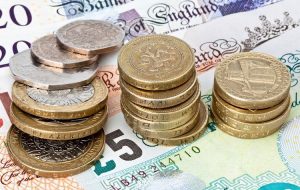Pound Sterling remains well-supported amid robust GDP growth
[ad_1] Share: Pound Sterling faces selling pressure despite the UK economy turning out more resilient in June than expected. Upbeat United Kingdom factory data showcase optimism among producers in spite of a highly-inflated price environment. Monthly Industrial and Manufacturing Production data grew by 1.8% and 2.4% in June, respectively. The Pound Sterling (GBP) seems to

[ad_1]
- Pound Sterling faces selling pressure despite the UK economy turning out more resilient in June than expected.
- Upbeat United Kingdom factory data showcase optimism among producers in spite of a highly-inflated price environment.
- Monthly Industrial and Manufacturing Production data grew by 1.8% and 2.4% in June, respectively.
The Pound Sterling (GBP) seems to be grabbing a Currency of the Week tag as the United Kingdom’s factory data for June and the April-June Gross Domestic Product (GDP) grew stronger than expectations. The GBP/USD pair fails to maintain recovery as market sentiment turns sour on stronger-than-anticipated United States Producer Price Index (PPI) data.
Upbeat United Kingdom factory data demonstrate optimism among producers in spite of high inflation and tight monetary policy conditions. Stronger-than-expected GDP growth indicates that the economy will manage to avoid recession comfortably. Robust economic growth would allow Bank of England (BoE) policymakers to raise interest rates further. After solid GDP growth, investors will shift their focus to the labor market data, which will be published on Tuesday at 06:00 GMT.
Daily Digest Market Movers: Pound Sterling reacts to cautious market mood
- Pound Sterling rises strongly as Q2 GDP data outperforms market expectations.
- Monthly GDP came out of contraction and grew by 0.5% vs. expectations of 0.2% growth. In the January-March quarter, the growth rate contracted by 0.1%.
- Quarterly GDP grew by 0.2% while analysts had forecasted a stagnant performance. The annual growth rate was 0.4%, doubled the consensus and the prior release of 0.2%.
- Monthly Industrial Production for June expanded strongly by 1.8% against the estimates for 0.1% growth. In May, the economic data contracted by 0.6%. Annual data rose significantly to 3.1%.
- Also, Manufacturing Production grew strongly by 2.4% against 0.2% as forecasted on a monthly basis.
- No doubt, UK factory data beat estimates by a wide margin and demonstrates fresh optimism among producers despite aggressively tight interest rate policy by the Bank of England.
- Stronger-than-expected UK growth rate indicates that the economy could manage to avoid recession this year.
- The reasoning behind sheer optimism among producers seems to be easing inflationary pressures and resilient consumer spending.
- Upbeat factory data would comfort BoE policymakers and allow them to raise interest rates further so that core inflation could return to a 2% rate quickly as fears of recession recede sharply.
- The BoE has already raised interest rates to 5.25% and further policy tightening is widely anticipated.
- Market mood dampens as investors remain worried that China could retaliate against a ban on US investment in specific hi-tech Chinese industries.
- The US Dollar Index (DXY) turns sideways around 102.50 after a solid recovery as the United States Consumer Price Index (CPI) rose moderately in July due to rising house rentals and a minor recovery in gasoline prices.
- US inflation advances at a 0.2% pace in July, in line with the Federal Reserve’s (Fed) desired rate of 2% core inflation growth. This would allow the Fed to maintain interest rates steadily and provide a comma to its aggressive rate-tightening spell.
- US inflation looks good on its softening path along with a historically low Unemployment Rate, which would allow the economy to avoid a recession.
- Meanwhile, San Francisco Fed Bank President Mary Daly joins Philadelphia Fed Bank President Patrick Harker and New York Fed President John Williams, saying that the central bank could discuss rate cuts next year but is largely dependent on the economy and inflation.
Technical Analysis: Pound Sterling remains well-supported above 1.2700
Pound Sterling rebounds sharply above the round-level resistance of 1.2700 after remaining sideways around 1.2680 following UK factory data that beat expectations. The Cable comes out of the fire but is still in the frying pan as it trades below the 20 and 50-day Exponential Moving Averages (EMAs). On Thursday, the asset attempted to climb above the 20-day EMA but faced an intense sell-off and turned vulnerable. The major failed to return to the Rising Channel chart pattern after a breakdown formed on the daily chart.
BoE FAQs
The Bank of England (BoE) decides monetary policy for the United Kingdom. Its primary goal is to achieve ‘price stability’, or a steady inflation rate of 2%. Its tool for achieving this is via the adjustment of base lending rates. The BoE sets the rate at which it lends to commercial banks and banks lend to each other, determining the level of interest rates in the economy overall. This also impacts the value of the Pound Sterling (GBP).
When inflation is above the Bank of England’s target it responds by raising interest rates, making it more expensive for people and businesses to access credit. This is positive for the Pound Sterling because higher interest rates make the UK a more attractive place for global investors to park their money. When inflation falls below target, it is a sign economic growth is slowing, and the BoE will consider lowering interest rates to cheapen credit in the hope businesses will borrow to invest in growth-generating projects – a negative for the Pound Sterling.
In extreme situations, the Bank of England can enact a policy called Quantitative Easing (QE). QE is the process by which the BoE substantially increases the flow of credit in a stuck financial system. QE is a last resort policy when lowering interest rates will not achieve the necessary result. The process of QE involves the BoE printing money to buy assets – usually government or AAA-rated corporate bonds – from banks and other financial institutions. QE usually results in a weaker Pound Sterling.
Quantitative tightening (QT) is the reverse of QE, enacted when the economy is strengthening and inflation starts rising. Whilst in QE the Bank of England (BoE) purchases government and corporate bonds from financial institutions to encourage them to lend; in QT, the BoE stops buying more bonds, and stops reinvesting the principal maturing on the bonds it already holds. It is usually positive for the Pound Sterling.
.
[ad_2]
لینک منبع : هوشمند نیوز
 آموزش مجازی مدیریت عالی حرفه ای کسب و کار Post DBA آموزش مجازی مدیریت عالی حرفه ای کسب و کار Post DBA+ مدرک معتبر قابل ترجمه رسمی با مهر دادگستری و وزارت امور خارجه |  آموزش مجازی مدیریت عالی و حرفه ای کسب و کار DBA آموزش مجازی مدیریت عالی و حرفه ای کسب و کار DBA+ مدرک معتبر قابل ترجمه رسمی با مهر دادگستری و وزارت امور خارجه |  آموزش مجازی مدیریت کسب و کار MBA آموزش مجازی مدیریت کسب و کار MBA+ مدرک معتبر قابل ترجمه رسمی با مهر دادگستری و وزارت امور خارجه |
 مدیریت حرفه ای کافی شاپ |  حقوقدان خبره |  سرآشپز حرفه ای |
 آموزش مجازی تعمیرات موبایل آموزش مجازی تعمیرات موبایل |  آموزش مجازی ICDL مهارت های رایانه کار درجه یک و دو |  آموزش مجازی کارشناس معاملات املاک_ مشاور املاک آموزش مجازی کارشناس معاملات املاک_ مشاور املاک |
برچسب ها :BOE ، GBPUSD ، GDP ، Growth ، inflation ، Pound ، remains ، robust ، seo ، Sterling ، wellsupported
- نظرات ارسال شده توسط شما، پس از تایید توسط مدیران سایت منتشر خواهد شد.
- نظراتی که حاوی تهمت یا افترا باشد منتشر نخواهد شد.
- نظراتی که به غیر از زبان فارسی یا غیر مرتبط با خبر باشد منتشر نخواهد شد.





ارسال نظر شما
مجموع نظرات : 0 در انتظار بررسی : 0 انتشار یافته : ۰